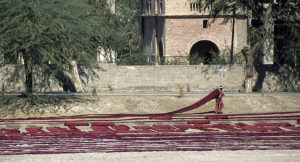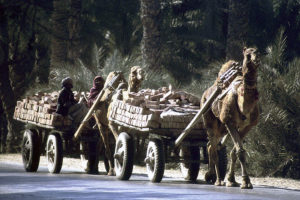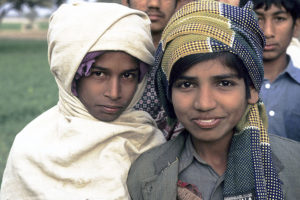Kaj Halberg - writer & photographer
Travels ‐ Landscapes ‐ Wildlife ‐ People
Pakistan 1978: Encounter with robbers
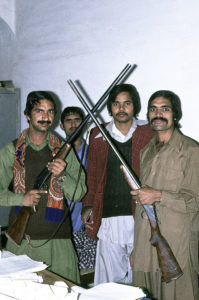
The following morning, we get entry stamps in our passports and other documents. Before we are permitted to leave, a soldier must control our passports, disappearing into a fort-like building with them. We then have to leave by the ‘entrance’ (marked by rolls of barbwire), drive around a huge area, enclosed by barbwire, and then proceed by another road into Pakistan. Once again, we are stopped by a soldier, armed with a pair of sunglasses, who also wants to control our passports. He informs us that the distance to the border town proper, Nokkundi, is 150 km, and wants to know if we have enough petrol.
Bird life here mainly consists of small, drab passerines, whose colours blend well with the landscape, including hoopoe lark (Alaemon alaudipes), crested lark (Galerida cristata), and desert lark (Ammomanes deserti).
It takes us almost all day to drive the 150 km to Nokkundi. Late in the afternoon, we arrive at the customs office, a tiny collection of adobe buildings, clustered around a railway station. The paper work in the customs office is quickly done, despite an overwhelming number of documents that have to be filled in. It appears, however, that the customs officer isn’t overloaded with work. No other foreign car has entered the country for four days!
We park in front of the tourist office to spend the night here. The following morning, the young man in charge kindly invites us for tea in his tiny kitchen. He has been living here for a year, alone, and a servant has only recently been provided. Over the village, a flock of brown-necked ravens (Corvus ruficollis) fly about, making a racket. In many desert areas, this species replaces the widespread common raven (C. corax).
Further east, around the town of Dalbandin, we encounter beautiful, golden sand dunes, the highest of them about 100 m tall. In this area lives a variety of wildlife, including species of sandgrouse (Pterocles), Macqueen’s bustard (Chlamydotis macqueeni), jeeber gazelle (Gazella fuscifrons), golden jackal (Canis aureus), and grey wolf (Canis lupus). Here and there are small groves, or tiny settlements of adobe huts with thatched roofs. The locals are tall and handsome, the bearded men wearing a long cloth, wrapped around their head as a turban.
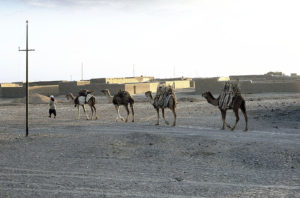
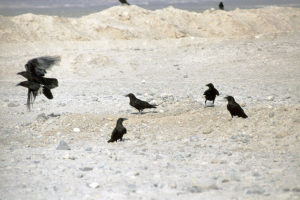
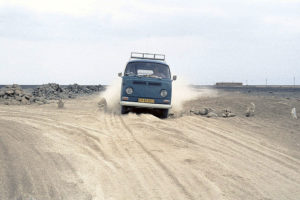
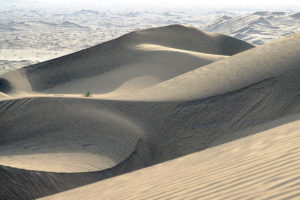
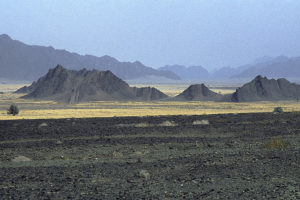
Two men pass by with their camels. One of them approaches us to ask for water. By using sign language, he informs us that he and his companion are on their way into the desert to collect firewood. The night is silent, and the sky is dotted with countless stars, as clear as they can only be in a desert sky.
The following day, the road is tarred, but full of pot-holes, so our progress is very slow. Nomads walk along the road with their camels and donkeys, loaded with tents, kitchenware, children, puppies, and chickens. Flocks of goats and sheep roam the area to find a tuft of grass, or an inviting twig, and boys are busy trying to keep the flocks moving.
During our lunch break, we are paid a visit by two Germans, on their way towards Iran. We wonder whether they are smuggling hash, as they are very concerned about the strict border control in Afghanistan. When they learn that we sleep in our car at the edge of the road, one of them says earnestly: “Es gibt hier Banditen!”
Oh yes, they are everywhere, we think.


Along the road, a couple of boys are selling jujube berries (Ziziphus mauritiana). Their taste is somewhat insipid, but nevertheless they are considered a delicacy by the locals. This species is described on the page Plants: Plants in folklore and poetry.
In the evening, a storm approaches, filling the air with dust. The wind blows all night long, and some of the morning as well.
Finally, we enter a large plain, criss-crossed by channels, which irrigate fields of rice and sugarcane. Groups of huge banyan trees (Ficus benghalensis) provide shade along the road, where squeaking ox-carts move at a snail’s pace. Slender camels appear to be moving in slow-motion, but due to their long gait they advance surprisingly quickly. In small puddles along the road, little egrets (Egretta garzetta), black-winged stilts (Himantopus himantopus) and other birds are feeding.
The harsh environment of Baluchistan and its bandits are now behind us. This is Sind, the fertile land along the Indus River – one of the cradles of civilization. In the 1920s, ruins of two Dravidian towns, Mohenjodaro and Harappa, were excavated here.
During the peak of a sophisticated civilization, c. 2500 B.C., the towns of this area were supplied with streets, sewage systems, baths, and storehouses for grain. The society was hierarchic. People had a pictorial alphabet, which has not yet been deciphered. Human-like gods, and possibly trees, were worshipped. Craftmanship and trade were prosperous.
As early as 1700 B.C., however, this civilization began to crumble, probably due to ecological disasters, such as flooding or increased desertification. When, around 1500 B.C., Aryan horsemen from the Iranian steppes invaded the Indus Valley, they only encountered poor remnants of the former glory. The Aryans had no difficulty subduing the local Dravidians and make them their slaves.
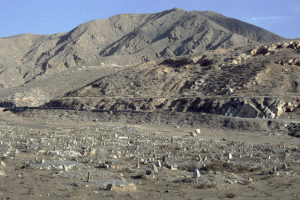
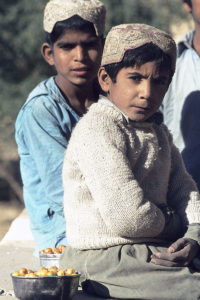
A small Asian mongoose (Herpestes javanicus) spurts along a canal, but stops abruptly to investigate us, standing on its hindlegs and staring at us with small, ruby-red eyes. “Rikki-tikki-tisj,” it hisses and moves on, gone in a blur. This call caused Rudyard Kipling, in his Jungle Book, to use the name Rikki-tikki-tavi for the mongoose.
While we are cooking, a couple of young men approach us to talk, most of the ‘conversation’ done by sign language, as none of them speak any English. Like most people we have met on our journey, they are deeply interested in our belongings, commenting on everything: binoculars, cameras, books, kitchenware etc. They stay in the area, but this is of no concern for us. We suppose they have their business to attend to.
Herds of cattle are driven home towards the villages, raising dense clouds of dust. They are followed by the ubiquitous cattle egrets (Bubulcus coromandus), which eat grasshoppers and other small creatures, flushed by the cattle. The sun disappears in a yellow haze, and darkness quickly sets in, and we arrange our cots for the night.
Our old Volkswagen van has no inner lock in the cabin, so before leaving Denmark, Arne welded a hook and a large bolt on the inside of the sliding door and the door frame. This means that we can close the door from inside, but not lock it. From outside, only a tiny crack can be opened. The ‘cockpit’ and the cabin are separated by a grate, bolted onto the frame between the two sections.

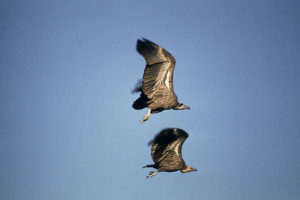
Looking through the rear window, we see three men with scarves tied around their face, illuminated by the light from a passing truck. When they hear that we are awake they forget everything about being cautious and proceed to hammer on the rear window and jerk at the sliding door. The hook creaks, but withstands the strain.
“What do we do? Can we unbolt the grate?”
“No, the spanner is stored under the front seat!”
We ransack our brains.
“Do you think we can scare them by showing them that we are armed?”
From our boxes, we dig out two large jambias, sharp and pointed daggers that we bought from bedouins in Jordan. Arne sticks out his dagger through the slit in the door, and there is a moment of silence out there. But then the noise resumes – it seems that they want our belongings, daggers or no daggers.
Now we are really in trouble – it can only be a matter of time before they get so desperate that they will smash the rear window. At this very moment, we hear the welcome sound of an approaching truck.
“Quick,” says Arne, “signal with the loft light!”
I signal like crazy, and the miracle happens – the truck comes to a stop! Arne opens the door, sprinting towards the truck, waving his arms wildly. The two men in the truck stare at him, horrorstricken. A mad foreigner with a large dagger in his hand!
Arne realizes that he is still carrying it, and, tossing it on the ground, he attempts to explain what has happened. They don’t understand a word of it, shake their head and prepare to continue their journey.
“Okay,” shouts Arne, waving to them while running back towards our car. “Let’s get out of here!”
Meanwhile, I have been sitting in the door opening, dagger in my hand, unable to do anything at all. But luckily, the robbers are long gone.
Like madmen, we now race along the road. Arne is so excited that he is driving in the right side of the road (which, incidentally, is the wrong side in Pakistan). Only when an approaching car begins to signal frantically with its headlights, he jerks the steering wheel to the left.
“Let’s find a petrol station,” he says, “no more truck stops tonight!”
I readily agree to this. At a service station, the friendly personnel are not at all mad to be woken at this hour, but kindly allow us to park our car behind the building. A barn owl (Tyto alba) flies over, uttering its ‘woman-in-distress’ scream – a suitable end to a hair-rising evening!
Finally, we are able to find a bank where we can change our cheques. This bank is very well guarded by two men, carrying rifles. (See picture at the top of this page.) The staff is very friendly, offering us tea, and when the formalities are done with, two of the clerks join us on a trip in the neighbourhood, where we visit local farmers.
What a difference between these friendly people, and the ones who tried to rob us!
